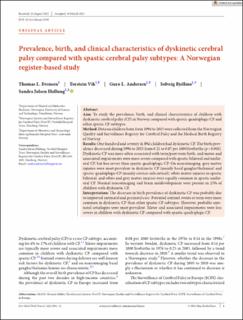| dc.contributor.author | Evensen, Thomas L. | |
| dc.contributor.author | Vik, Torstein | |
| dc.contributor.author | Andersen, Guro Lillemoen | |
| dc.contributor.author | Bjellmo, Solveig | |
| dc.contributor.author | Hollung, Sandra Julsen | |
| dc.date.accessioned | 2023-09-12T06:10:05Z | |
| dc.date.available | 2023-09-12T06:10:05Z | |
| dc.date.created | 2023-04-10T10:33:06Z | |
| dc.date.issued | 2023 | |
| dc.identifier.issn | 0012-1622 | |
| dc.identifier.uri | https://hdl.handle.net/11250/3088753 | |
| dc.description.abstract | Aim: To study the prevalence, birth, and clinical characteristics of children with dyskinetic cerebral palsy (CP) in Norway compared with spastic quadriplegic CP and other spastic CP subtypes. Method: Data on children born from 1996 to 2015 were collected from the Norwegian Quality and Surveillance Registry for Cerebral Palsy and the Medical Birth Registry of Norway. Results: One hundred and seventy (6.8%) children had dyskinetic CP. The birth prevalence decreased during 1996 to 2015 from 0.21 to 0.07 per 1000 livebirths (p < 0.001). Dyskinetic CP was more often associated with term/post-term birth, and motor and associated impairments were more severe compared with spastic bilateral and unilateral CP, but less severe than spastic quadriplegic CP. On neuroimaging, grey matter injuries were most prevalent in dyskinetic CP (mainly basal ganglia/thalamus) and spastic quadriplegic CP (mainly cortico-subcortical), white matter injuries in spastic bilateral, and white and grey matter injuries were equally common in spastic unilateral CP. Normal neuroimaging and brain maldevelopment were present in 25% of children with dyskinetic CP. Interpretation: The decrease in birth prevalence of dyskinetic CP was probably due to improved antenatal and perinatal care. Potential sentinel events at term were more common in dyskinetic CP than other spastic CP subtypes. However, probable antenatal aetiologies were most prevalent. Motor and associated impairments were less severe in children with dyskinetic CP compared with spastic quadriplegic CP. | en_US |
| dc.language.iso | eng | en_US |
| dc.relation.uri | https://onlinelibrary.wiley.com/share/author/UMCMVKAPD8TINKIETQWM?target=10.1111/dmcn.15598 | |
| dc.rights | Attribution-NonCommercial-NoDerivatives 4.0 Internasjonal | * |
| dc.rights.uri | http://creativecommons.org/licenses/by-nc-nd/4.0/deed.no | * |
| dc.title | Prevalence, birth, and clinical characteristics of dyskinetic cerebral palsy compared with spastic cerebral palsy subtypes: A Norwegian register‐based study | en_US |
| dc.title.alternative | Prevalence, birth, and clinical characteristics of dyskinetic cerebral palsy compared with spastic cerebral palsy subtypes: A Norwegian register‐based study | en_US |
| dc.type | Peer reviewed | en_US |
| dc.type | Journal article | en_US |
| dc.description.version | publishedVersion | en_US |
| dc.source.journal | Developmental Medicine & Child Neurology | en_US |
| dc.identifier.doi | 10.1111/dmcn.15598 | |
| dc.identifier.cristin | 2139764 | |
| cristin.ispublished | true | |
| cristin.fulltext | original | |
| cristin.qualitycode | 1 | |

